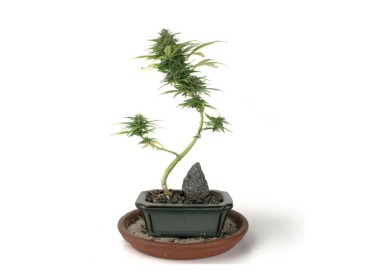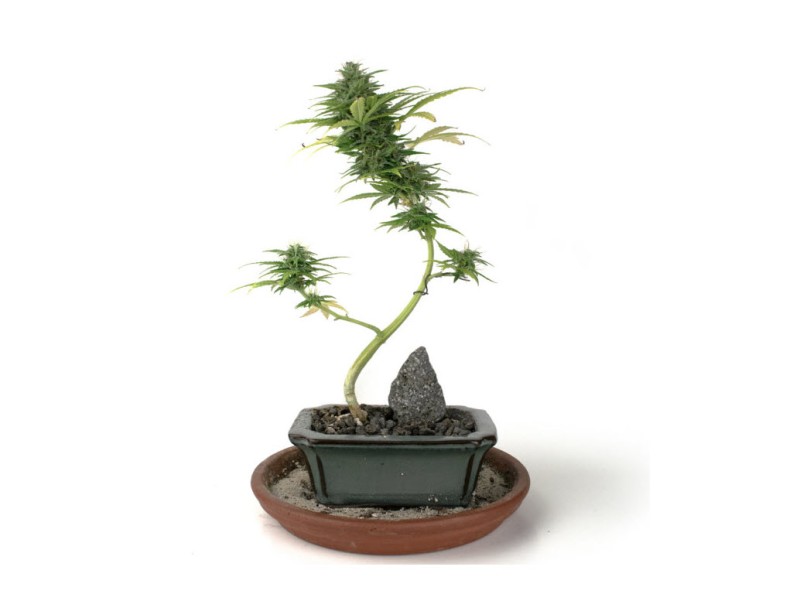
The attention of cannabis enthusiasts has once again focused on cannabis bonsai trees. Considered a myth in the past, these trees are real.
This tree takes time and effort to groom into something perfect or close to perfect. Cannabis growers who have grown a cannabis bonsai tree claim the best part of the activity is the personal and engaging relationship they fostered with their plant, as well as the soothing joy, peace, and quiet they enjoyed during the nurturing process. Growing a healthy bonsai tree takes hard work and commitment, but it's worth it.
What is a bonsai tree?
A bonsai tree is a plant grown in a container. It is often regarded as a tiny tree. The practice of growing bonsai trees uses a growing technique guaranteed to keep the trees at their small sizes, despite their age. It involves a lot of branch-wiring, running, precise fertilizer application, and other intricate details. This cultivation involves practices that keep the plant at a fraction of its natural size without compromising its quality.
To grow the best bonsai trees, you have to be prepared to put in the work. Most of the time, it's not about the gorgeous-looking plant produced at the end, but rather the time and experience gained from the bonsai culture.
The Origin and Purpose of Bonsai Trees
These plants have been around for more than a thousand years. It can be traced to ancient Japan and China. The word "bonsai" is a Japanese word that means "to plant in a container." It is often mistaken as a tree species.
The belief that this subtle art of cultivating trees in containers helps individuals connect with their Zen has been passed down through Buddhist teachings over centuries. Old China has more connections to the bonsai culture.
The overall goal of nurturing a bonsai tree is to create a natural plant similar to its biological parent plant. The only observable difference between the two is their size. The small size of the plant is due to the container size. The trees cannot absorb required nutrients or develop broad root systems due to the restrictions in the container. Bonsai trees are not genetically different from naturally occurring species, and almost all kinds of species can be cultivated into bonsai plants. Cannabis growers who have grown cannabis bonsai trees recommend strains that grow to be woody with smaller leaves and less extensive root systems, perfect for bonsai. This way, it is not difficult to have a reduced size.
Cannabis Bonsai Trees
In the quest to develop the best buds with potent cannabinoids, the practice of growing and maintaining cannabis bonsai trees came to be. These plants are usually no longer than a few centimeters and are often used as a source of clone clippings, then planted outdoors or indoors. These mother plants are not genetically different from the full-grown mother plants, and the yield clippings have similar genetic and physical features.
Another advantage of cannabis bonsai trees is that they encourage genetic diversity in a cannabis farm or garden. It takes away the dependence on seeds. This utility is best witnessed rather than explained. With more than one cannabis bonsai mother plant, your cannabis garden can house plants with unique genetic characteristics.
Cannabis bonsai trees take very little space and, like other bonsai trees, require minimal resources. Despite the rumors that it is challenging to grow and maintain, with the right strategies, it is pretty easy to set up.
Cultivating a Cannabis Bonsai Tree
First off, you need materials. Some of these materials include a young cannabis plant, a twine or polythene-covered wire, a wooden stake, an electric drill, and most importantly, a container.The process of growing a canna-bonsai tree is divided into five steps.
1–Preparation
The first thing that must be prepared for the plant is the pot.
Most containers used are preferably small in size. Holes are drilled into the container for the twines or wires to facilitate training (this is the process of suspending the tree's branches in the preferred direction). When drilling these numerous holes, ensure that they are wide enough for the twine. If they are not, take care to broaden them.
2—Transplanting the cutting (young plant)
Also known as trunk training. This step involves properly setting the chosen mother-plant into the container. Preferred strains for cannabis bonsai trees include Critical Kush and White Widow. These strains are healthy, sturdy, produce potent buds, and produce dozens of clippings many times a year.
With your wooden stake, position the trunk of the cutting in the desired position. This has to be done carefully to prevent potential root damage. It is best to gently press the stake into the soil as the stem goes in to make a clear path for the root.
3—Stem Training
Thread your twine through the previously drilled holes and tie it to the stem and stake.
Using too much force when attaching the swine could damage the cutting. The branches are also tied down with twine. Carefully add more pressure when tying if you prefer to have horizontal branches.
Double-check to ensure there is enough room for branches to grow without choking.
4–Pruning
Pruning is a year-round activity that must be performed for the cutting to retain its shape, size, and stature.
It also ensures adequate airflow is maintained. Experts recommend that only offshoot branches be pruned. Reducing the size of the main branches could have adverse effects on the growth and health of the plant.
5—Harvesting
When the plant reaches the flowering stage, it is harvested.
The buds are snipped off once they turn creamy white. Properly store and cure the harvested buds.
Final Note
The fantastic thing about cannabis bonsai trees is that they can be kept alive for about 2–5 years with effective nurturing. The hardest part of growing cannabis bonsai trees is usually the first year. Subsequent years require fewer resources and still produce potent buds.
These living, breathing works of art can be extended to flower for many years, returning the plant to a vegetative state through extensive pruning. You'll find that their regenerative potential gets more incredible with time.







